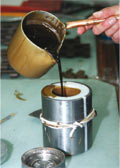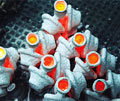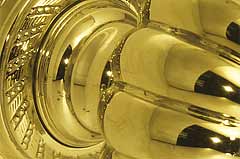THE LOST WAX PROCESS
More background information
- Video
- Video of cast iron bath manufacturing
- Video of lost wax casting
- Video of chinaware manufacturing
- Bathroom design
- Victorian bathroom design
- Create an art deco bathroom suite
- How to restore your bathroom
- Nine Reasons not to restore your bathroom
- Door furniture
- The secrets behind buying traditional door knobs
- The lost wax process
- Bathroom techniques
- Bath casting
- Bath enamelling
- Bath finishing
- External links
How to make the best door furniture
Time, patience and skill: that's what it takes Drummonds to make each elegantly curved bathroom tap, or elaborately detailed door knob or handle. Each item takes more than a month to manufacture in solid brass by hand.
So how do we do it? We use the traditional lost wax process, an ancient method of casting that dates back thousands of years to ancient Egypt and China. It remains the best method for capturing exquisite detail in brass.
This little used process uses wax to create a base model with ultra fine detail and flowing curves. A plaster cast is created from the wax, which can then be melted away — lost. Molten metal can then be poured into the plaster.
Below, we take you step by step through the process of manufacturing a brass door knob using this traditional method.
We also have a video of the lost wax process on this site.
Step 1: Making a wax model
 An original pattern of every part is first made in wax by pouring molten wax into a master mould.
An original pattern of every part is first made in wax by pouring molten wax into a master mould.

 The wax is left to set, creating a very detailed model in wax.
The wax is left to set, creating a very detailed model in wax.
Step 2: Making a plaster cast
 The wax originals are encased in several layers of hard ceramic plaster and left to dry. A very fine grain of sand is applied first to ensure the detail of the piece is kept.
The wax originals are encased in several layers of hard ceramic plaster and left to dry. A very fine grain of sand is applied first to ensure the detail of the piece is kept.

 Once dry, the plaster jacket is placed in boiling water and the wax is melted away – lost - and recycled. It is then washed through in preparation for
molten brass.
Once dry, the plaster jacket is placed in boiling water and the wax is melted away – lost - and recycled. It is then washed through in preparation for
molten brass.
Step 3: Baking the plaster
 The plaster cast is baked in the furnace to achieve a rock hard mould.
The plaster cast is baked in the furnace to achieve a rock hard mould.
Step 4: Adding the brass
 Molten brass is then poured into the plaster cast.
Molten brass is then poured into the plaster cast.
 The molten brass is left to harden. Then, the plaster can be broken away, leaving the newly made brass pieces.
The molten brass is left to harden. Then, the plaster can be broken away, leaving the newly made brass pieces.
Step 5: Finishing

 Each component is then drilled, threaded, cut and lathed by hand.
Each component is then drilled, threaded, cut and lathed by hand.
 In keeping with tradition, brass is not lacquered, only polished, allowing items to age gracefully. This is done by hand, by a skilled craftsperson, for the luxurious feel not possible with machine polishing.
In keeping with tradition, brass is not lacquered, only polished, allowing items to age gracefully. This is done by hand, by a skilled craftsperson, for the luxurious feel not possible with machine polishing.
Results
 Close up of a Warham door knob, showing the quality of the intricate detail that can be achieved with the lost wax process.
Close up of a Warham door knob, showing the quality of the intricate detail that can be achieved with the lost wax process.
See more door knobs
Site links - made with the lost wax process:

